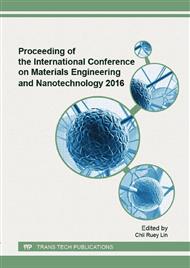[1]
Cebeci, O.Z., S.I. Al-Noury, and W.H. Mirza, Strength and drying shrinkage of masonry mortars in various temperature humidity environments. Cement and Concrete Research, 1989. 19: pp.53-62.
DOI: 10.1016/0008-8846(89)90065-3
Google Scholar
[2]
Toledo, R.D., et al., Free, restrained and drying shrinkage of cement mortar composites reinforced with vegetable fibres. Cement & Concrete Composites, 2005. 27(5): pp.537-546.
DOI: 10.1016/j.cemconcomp.2004.09.005
Google Scholar
[3]
Videla, C. and C. Aguilar, An updated look at drying shrinkage of Portland and blended Portland cement concretes. Magazine of Concrete Research, 2006. 58(7): pp.459-476.
DOI: 10.1680/macr.2006.58.7.459
Google Scholar
[4]
Neville, A.M., Properties of Concrete, 2nd Edition. 1973, London: Pitman Publishing. 687.
Google Scholar
[5]
Bissonnette, B., P. Pierre, and M. Pigeon, Influence of key parameters on drying shrinkage of cementitious materials. Cement and Concrete Research, 1999. 29: pp.1655-1662.
DOI: 10.1016/s0008-8846(99)00156-8
Google Scholar
[6]
Bazant, Z.P., Prediction of concrete creep and shrinkage: past, present and future. Nuclear Engineering and Design, 2001. 203: pp.27-38.
DOI: 10.1016/s0029-5493(00)00299-5
Google Scholar
[7]
Gardner, N.J., Comparison of prediction provisions for drying shrinkage and creep of normal-strength concretes. Canadian Journal of Civil Engineering, 2004. 31: pp.767-775.
DOI: 10.1139/l04-046
Google Scholar
[8]
Hansen, W., Constitutive Model for Predicting Ultimate Drying Shrinkage of Concrete. Journal of the American Ceramic Society, 1987. 70(5): pp.329-332.
DOI: 10.1111/j.1151-2916.1987.tb05003.x
Google Scholar
[9]
Grassl, P., H. Wong, and N. Buenfeld, Influence of aggregate size and volume fraction on shrinkage induced micro-cracking of concrete and mortar. Cement and concrete research. 40(1): pp.85-93.
DOI: 10.1016/j.cemconres.2009.09.012
Google Scholar
[10]
Vandeperre, L.J., M. Liska, and A. Al-Tabbaa. A comparison between two types of pfa in the performance of blends of MgO, PC and pfa. in Ashtech 2006. 2006. Birmingham: United Kingdom Quality Ash Assocation.
Google Scholar
[11]
Garci Juenger, M.C. and H.M. Jennings, Examining the relationship between the microstructure of calcium silicate hydrate and drying shrinkage of cement pastes. Cement and Concrete Research, 2002. 32: pp.289-296.
DOI: 10.1016/s0008-8846(01)00673-1
Google Scholar
[12]
Vandeperre, L.J., J. Wang, and W.J. Clegg, Effects of porosity on the fracture energy of brittle materials. Philosophical Magazine, 2005. 84(34): pp.3689-3704.
DOI: 10.1080/14786430412331293522
Google Scholar
[13]
Mindess, S., J.F. Young, and D. Darwin, Concrete. second ed. 2003, Upper Saddle River: Prentice Hall. 644.
Google Scholar


